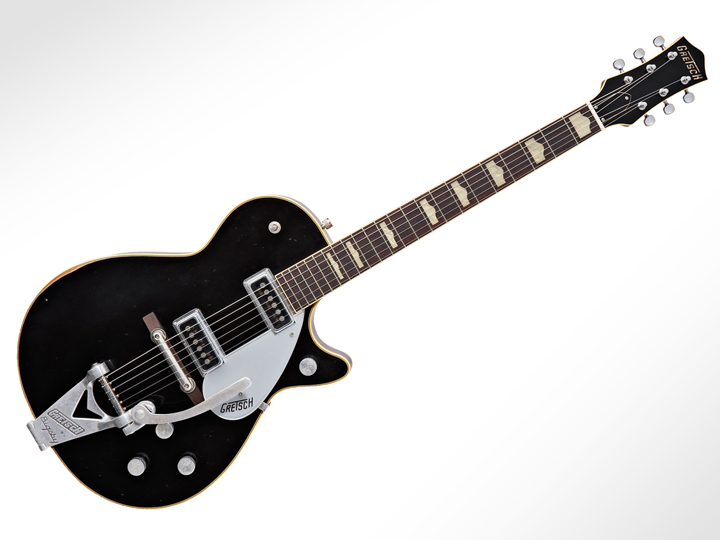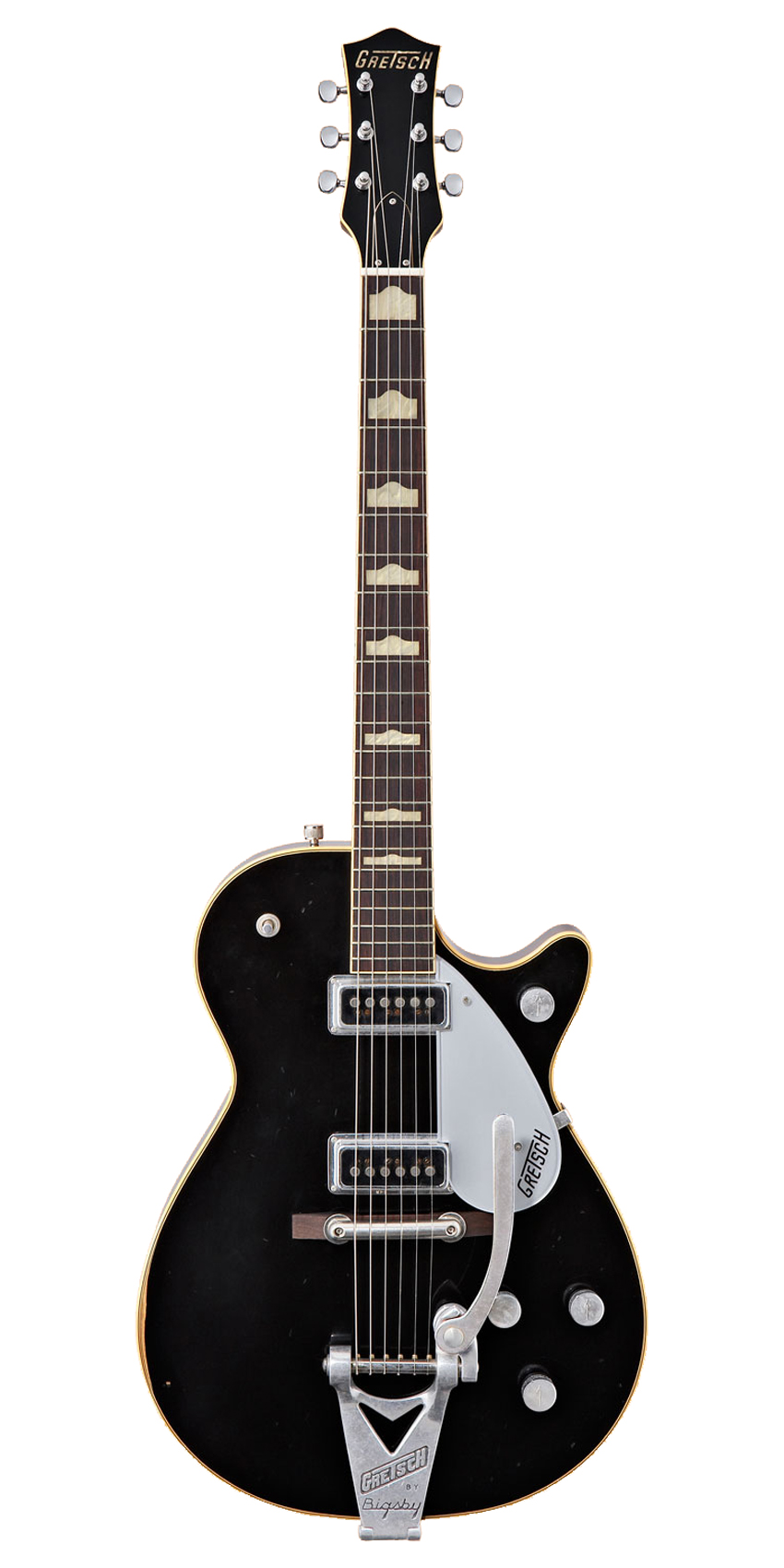MusicRadar Verdict
Gretsch has done an immaculate job of re-creating (and updating slightly) a guitar that is already timeless. If you can afford the price $6,500 US for one of the 75 models to be available, the time to buy is now.
Pros
- +
Beauty personified. Remarkable attention to detail. A look and sound unmatched then and now.
Cons
- -
Tuning can be bothersome. Plus, there's the price (to be expected).
MusicRadar's got your back

Gretsch Duo Jet Relic review

Gretsch Duo jet Relic review
Can a replica still be considered a work of art? In the case of Gretsch's lovingly crafted G6128TDS-R Duo Jet Relic Limited Release, the answer is a most definitive yes. But as much as you'll want to hang it on the wall, this guitar is meant to be played.
The first thing we did was marvel at the tweed case, which has not four, not five, but six gold locks. As in: "Special contents inside. Nothing's dropping out of here." It's become a rare experience when a case alone gives us pause for thought, but this is a very handsome and sturdy piece of luggage, indeed.
Pop the locks and there it is...Whoa! Stand back a moment here and gaze. Roy Orbison, Duane Eddy, Chet Atkins, George Harrison, Brian Setzer, Chris Cornell - they've all played the Duo Jet. And right there it is, the perfect marriage of black and silver. Let's take this big guy out and go for a ride.
Design and construction
When first released in 1954, the Duo Jet was one of the first mahogany-bodied electric guitars to be extensively routed inside (making it, in effect, a semi-solid). The Limited Release's chambered body features a 3-ply arched maple top. Tap on the top and the guitar makes that wondrous echo-y kind of sound - there's music to be made with this thing. All in all, the body, which measures 13-1/4 inches wide and 1-3/4 inches in depth (slightly more towards the bottom), feels remarkably light yet substantial, the kind of guitar that won't kill your shoulder by the end of a set. There are two knurled strap retainer knobs.
Okay, time to consider the finish, an astonishing veneer. The nitrocellulose lacquer, graciously applied to the top and the walnut-stained sides and back, has been "relic'd" - aged - and it's quite astonishing in that the little nicks and dents and patches of cracked paint are entirely intentional. Flip the guitar over and what do you know? There's even belt marks on this thing! Now, how did they do that? A brand-new guitar that looks convincingly like an antique - extraordinary.
The binding that runs along the top edge is sufficiently "relic'd" as well, so it has a bit of a brownish hue. Very nice. There is a classic-shaped Gretsch silver Plexiglas pickguard (with the Gretsch logo) that, on its straight side, extends from the last fret to the bridge. The body's single-cutaway allows smooth and easy access to to the last fret and beyond.
Want all the hottest music and gear news, reviews, deals, features and more, direct to your inbox? Sign up here.
The C-shaped neck, bound at the back where it meets the body (at the 16th fret), is a one-piece mahogany construction with the same nitrocellulose lacquer as what is on the rest of the guitar. The binding along the sides has also been aged - the same brownish hue is visible by the first and second frets. With a scale length of 24.60 inches and 21 frets, the neck feels fast and easy in the hand.
The rosewood fingerboard features eight aged hump block inlay position markers. With a 12-inch fretboard radius, the neck has the nice, rounded feel of a classic - the kind of guitar you can bend strings on without worrying about fretting out, but you can still wrap your hand around barre chords. Fretting is more like tap-dancing. In fact, we found ourselves at first shooting past intended frets, but after a minute or two we acclimated ourselves to this slick-playing baby.
The back-angled, bound headstock features an aged pearloid Gretsch logo. The width at the nut (the material of which wasn't specified) measures 1-11/16 inches. A black cover hides the adjustable headstock. The tuning gears are aged and chrome-plated Grover V98G Sta-Tites. And herein lies our one beef with the guitar, and unfortunately it's something of a biggie: whether it was the tuning heads or the realities of working with the Bigsby vibrato, the Duo Jet Relic Limited Release is not the best at staying in tune. We were tuning frequently, even after bending out the strings.
Hardware and electronics
The new Duo Jet's bridge differs from the classic '57 model. Whereas the original sported a very intricate-looking Synchro-Sonic bridge that had movable string rests, the Relic features a rosewood-based "Rocking" Bar Bridge - basically, it's one piece with six grooves for the strings to pass through. The appearance is very no-fuss, no-muss, and according to Gretsch the new bridge is designed for greater tone and sustain.
The pickups on the Relic are also different: The '57 Duo Jet came equipped with two single-coil DeArmond pickups (revered by such echo kings as Cliff Gallup). The new model features two Seymour Duncan DynaSonic single-coils. Having actually played the original, we have to say that the Duncans do a credible, even admirable, job of maintaining a vintage sound and updating it ever-so-slightly. They are controlled via a 3-way toggle switch located on the left corner of the guitar's upper body.
Located just outside of the right wing is the master volume, a round, aged, chrome-plated knob with the familiar arrow adornment. Towards the lower right of the body are similar controls for the bridge, bridge and neck, and neck pickups.
We were dying to remove any of the guitar's three back plates to inspect the wiring, but the thought of taking a screwdriver to a guitar this gorgeous (and expensive) was more than we could bear. Best left to the imagination.
The Gretsch Bigsby B3C vibrato tailpiece, also aged and chrome plated, is a solid piece of metal that is remarkably touch-sensitive. We didn't have to strong-arm the bar in the slightest; in fact, it's as smooth and supple to manipulate as the latest whiz-bang vibratos out there. But there is a depth of musicality to the Bigsby, this Bigsby in particular, that can't be ignored.
In use
One can easily play this guitar unplugged all day long. Despite our qualms about tuning, it's truly a great-sounding instrument. Plugged in, it sings a whole different tune - better, deeper, richer. Played clean in the first position, it delivers a warm jazz tone that ripples through the body (meaning ours, but you can feel it in the guitar too). Notes are round and resonant, with remarkable clarity. The second position reveals something different. The tone is more suited to country music - whether chords or arpeggios, there's a nice ring to the notes - but it has a bite too, a kind of right-down-the-middle-of-the-road sound that has its own kind of character.
The third position is pure rock 'n' roll. This is the sound that started it all. With the amp in a clean setting, we were able to nail some authentic, snaggle-toothed rockabilly strains from the Duo Jet. Crank up some overdrive and we could be right in line for that reunion of The Cult. But there's no washiness to the Duo Jet's wail - every note growls and gets its own space. And the Bigsby is a dream. We had to fight the temptation to end each phrase with vibrato.
Hear the Gretsch Duo Jet Relic Limited Release in action:
Neck pickup:
Middle setting:
Bridge pickup:
MusicRadar is the number one website for music-makers of all kinds, be they guitarists, drummers, keyboard players, DJs or producers...
- GEAR: We help musicians find the best gear with top-ranking gear round-ups and high-quality, authoritative reviews by a wide team of highly experienced experts.
- TIPS: We also provide tuition, from bite-sized tips to advanced work-outs and guidance from recognised musicians and stars.
- STARS: We talk to musicians and stars about their creative processes, and the nuts and bolts of their gear and technique. We give fans an insight into the craft of music-making that no other music website can.
